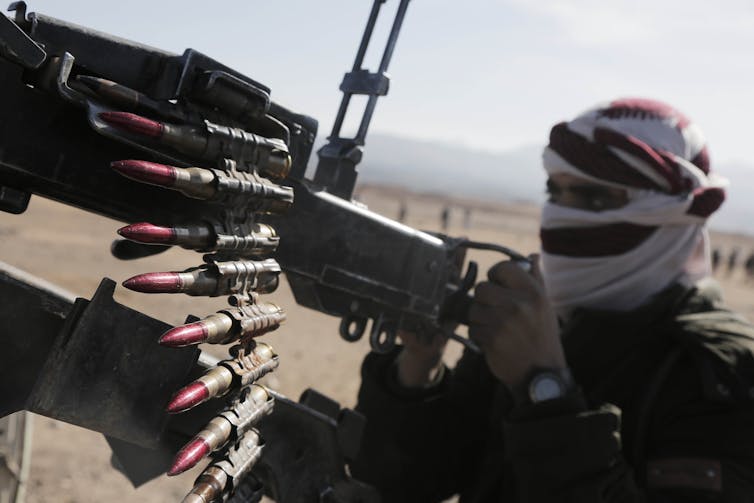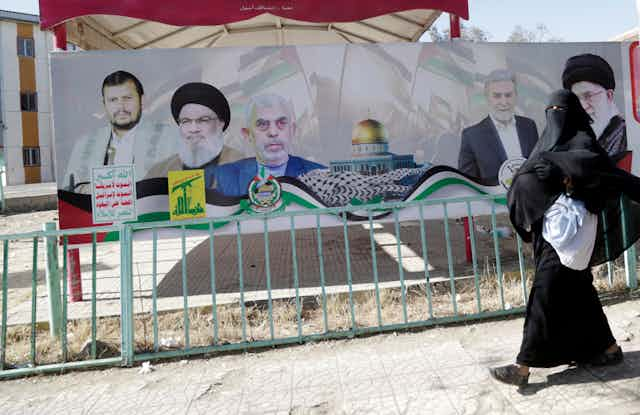From attacks by rebels in the Red Sea to raids in northern Israel and the Oct. 7, 2023, assault by Hamas, Western analysts have pointed a finger of blame toward Iran.
Regardless of how involved Tehran is directly in the planning and carrying out of such incidents, the accusations get at a broader truth: In Middle Eastern geopolitics, Iran’s strategy of aligning with violent nonstate actors – notably Hamas in Gaza, Hezbollah in Lebanon and the Houthis in Yemen – influences the regional balance of power.
As experts in Iran’s relationship with its network of proxies, we understand that Iran’s connection with each group is distinct yet interlinked, revealing Tehran’s regional objectives. From southern Lebanon to Gaza to Yemen, these alliances shape the political landscape and highlight the nature of influence and control in proxy warfare. It serves as a counterweight to Iran’s relatively limited conventional military capabilities, forming a key part of its foreign policy.
Iran’s ‘Axis of Resistance’
Managed by the Islamic Revolutionary Guard Corps, Iran’s paramilitary security service that answers only to Supreme Leader Ayatollah Ali Khamenei, these regional groups form what Tehran has labeled the Axis of Resistance.
The relationship between the groups and Tehran is designed to serve as a balance against both U.S. influence in the region and that of Washington’s regional allies, including Israel and Saudi Arabia.
But to characterize the Axis of Resistance as straight proxies is slightly off. Rather, Iran’s approach – spanning Iraq, Syria, Lebanon, Yemen and the Palestinian territories – is to extend its influence through strategic partnerships. While based on shared objectives and ideologies, these alliances allow varying degrees of autonomy. Iran provides resources and coordination, but each group maintains its own agenda and local support base, functioning more as partners than proxies. And the relationship between Iran and each member of this Axis of Resistance is unique.
Hezbollah: Iran’s pivotal partner
Established in the early 1980s, Hezbollah – a Shiite militant organization – emerged with direct assistance from Iran’s Revolutionary Guard, primarily as a response to the Israeli invasion of Lebanon. Aiming to establish an Iranian-influenced base on Israel’s border, Tehran provided training, financial support and weaponry, bolstering Hezbollah’s growth and capabilities.
This collaboration has led to Hezbollah developing a sophisticated arsenal, including advanced drone technology, chemical weapons and expanded rocket capabilities.
As a result of its involvement in the Syrian civil war and ongoing hostilities with Israel, Hezbollah has professionalized its military. By deploying troops to support the Syrian government in line with Iran’s support for the regime, Hezbollah has transitioned from guerrilla tactics to more conventional warfare. Additionally, its ongoing conflict with Israel has sharpened its military strategy and capabilities. This helped elevate Hezbollah to a notable political and military role within Lebanon’s government, which has frequently aligned with Iran’s geopolitical interests.
This evolution has also enabled Hezbollah to become a mentor and supporter for other Iran-backed groups. Hezbollah has imparted its expertise in drone operations to organizations such as Fatemiyoun in Afghanistan, Iraq’s Kataib Hezbollah and Houthi fighters.
The relationship between Tehran and Hezbollah has deepened over the years, evolving from mere assistance to a robust strategic alliance. The entities share goals, strategies and materials. The close relationship between Hezbollah’s Secretary General Hassan Nasrallah and Iran’s Khamenei further cements this alliance.
Despite Iran’s considerable influence, particularly in regional conflicts, Hezbollah retains autonomy in domestic Lebanese politics and its social services.
This Hezbollah-Iran alliance is arguably more significant than Iran’s relationship with other proxies and is instrumental in Tehran’s regional strategy. It not only extends Iran’s influence in the Middle East but also serves as a counterbalance to its adversaries, notably Israel and Saudi Arabia.
Hamas: United against Israel
Emerging in the first intifada, or Palestinian uprising, of 1987, Hamas forged ties with Iran in the early 1990s. Despite the ideological differences – Hamas is predominantly Sunni Islamist, while Iran is a hard-line Shiite regime – they found common ground in their opposition to Israel and a shared vision for Palestinian liberation.
Iran’s backing of Hamas includes financial aid, military training and, crucially, the supply of rocket technology. This funding has escalated Hamas’ operational capabilities, enabling the development of a more sophisticated and far-reaching rocket arsenal.
Iran’s support has shifted the balance in Hamas’ conflict with Israel, demonstrating Iran’s influential role in regional power dynamics.
The alignment between Iran and Hamas, however, has fluctuated. In 2012, differences over the Syrian civil war introduced a rift in their relationship. Hamas’ tacit support for Sunni rebels in Syria was at odds with Iran’s allegiance to the Assad regime, leading to a temporary withdrawal of Iranian support.
However, this strain was not permanent. In subsequent years, the Iran-Hamas relationship was realigned and reinforced, evidenced by Iran’s resumption of substantial military aid. The sophisticated planning and execution of the Oct. 7 attack showed how Hamas has been able to improve its military capacity with a helping hand from Iran.
Nonetheless, the group maintains a degree of political and strategic independence, primarily focusing on Palestinian interests.
This dynamic reflects Iran’s broader regional strategy: to empower allied groups in extending its reach, while granting them autonomy to pursue specific agendas.
Houthis: Strategic ally against Saudi Arabia
Emerging in the 1990s in Yemen as a Zaidi Shia Islamist group, the Houthi movement initially focused on religious and cultural revivalism before progressively becoming engaged in Yemen’s political and military arenas.

Fueled by grievances against the central government and foreign interference in Yemen, the group shifted to an armed rebellion. This evolution was marked by growing confrontations with the Yemeni government and involvement in a wider regional conflict against a coalition led by Iran’s regional rival, Saudi Arabia. This set the stage for their alliance with Tehran.
The Houthis’ alignment with Iran was spurred by shared religious beliefs as well as opposition to both Saudi Arabia and the U.S.
The collaboration with Iran gained momentum following the Houthis’ capture of Yemen’s capital Sanaa in 2014 – a move that is believed to have triggered an escalation in Iranian support.
Support from Tehran came in the shape of sophisticated weaponry, military training and financial aid, and it has substantially enhanced the Houthis’ missile and drone capabilities. The Houthis have utilized this growing capability to challenge Saudi Arabia and, more recently, Israel
Empowered by Iranian support, the Houthis have expanded their operations to include assaults on U.S. and other international vessels in the Red Sea.
Despite the depth of Iranian support, the Houthis retain a level of autonomy, specifically in local Yemeni politics. While Iran’s influence is notable, it does not translate into outright control. Instead, the Houthis are positioned more as strategic allies within Iran’s regional agenda rather than mere proxies.
Iran’s expanding influence
Iran’s proxy network, which extends to groups in Iraq, Syria and beyond, is a key part of Tehran’s strategy to expand its influence and confront that of Washington and its allies.
These partnerships, though seldom involving absolute control, also demonstrate Iran’s adeptness in navigating geopolitical landscapes. The Axis of Resistance allows Iran to adapt its strategy to shifting regional dynamics. For example, positioning Hamas under the Revolutionary Guard’s guidance fits a strategy to confront Israel as regional dynamics shift toward normalization between Israel and Arab states.
Such partnerships also pose a challenge to Iran’s adversaries. Deterring these proxy groups requires navigating a complex web of relationships, interests and ongoing conflicts. And this complexity, coupled with Iran’s pivotal role, has reshaped the Middle East’s geopolitical landscape, signaling a period of heightened tensions with broad international implications.

